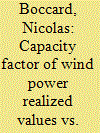|
|
|
Sort Order |
|
|
|
Items / Page
|
|
|
|
|
|
|
| Srl | Item |
| 1 |
ID:
088285


|
|
|
|
|
| Publication |
2009.
|
| Summary/Abstract |
This paper presents a summary of a local effort in California to assess greenhouse gas (GHG) emissions and identify potential mitigation measures. Local policymakers in California already have been searching for ways to reduce GHG emissions but it was the California Global Warming Solutions Act of 2006 (AB 32), which seeks to reduce GHG emissions to 1990 levels by 2020, that has provided a framework for regions to evaluate their ability to reduce GHG emissions. We conducted a GHG inventory for the San Diego region from 1990 to 2006, with forecasts to 2020. The region emitted approximately 34 million metric tons of carbon dioxide equivalent (MMT CO2E) in 2006 from anthropogenic sources, which represents a 17% increase over the 1990 level of 29 MMT CO2E. Applying a combination of 21 existing or pending state GHG reduction mandates and feasible regional measures we show that the region could achieve the AB 32 target. Although the largest reductions are achieved through state mandates, all measures, including at the local level, will be required to achieve the AB 32 target. Thus local regions retain control over a fairly significant portion of reductions, and remain important actors in the implementation and compliance of state mandates.
|
|
|
|
|
|
|
|
|
|
|
|
|
|
|
|
| 2 |
ID:
088021


|
|
|
|
|
| Publication |
2009.
|
| Summary/Abstract |
Recently a number of objections have been raised against the use of ethanol produced from agricultural products such as maize, sugarcane, wheat or sugar beets as a replacement for gasoline, despite some of their advantages such as being cleaner and to some extent renewable. We address these objections in this paper. Topics discussed include the "corn connection" (which was theorized to be a cause of deforestation in the Amazonia), the rise of food prices due to ethanol production and the real possibilities of ethanol in reducing greenhouse gas emissions. It has been shown that such concerns are grossly exaggerated and that ethanol from sugarcane, as produced in Brazil, is the preferred option for the production of fuel not only in terms of cost but also as a favourable energy balance. Finally, the possibility of expanding ethanol production to other sugar-producing countries is also discussed.
|
|
|
|
|
|
|
|
|
|
|
|
|
|
|
|
| 3 |
ID:
088258


|
|
|
|
|
| Publication |
2009.
|
| Summary/Abstract |
The links between emission and energy markets are of great interest to practitioners, academics and policy makers. In this paper, it is conjectured that a positive relationship exists between emission allowance spot returns and electricity risk premia within the European Union Emissions Trading Scheme (EU ETS). We discuss how this can be justified on the basis of the substantial uncertainties in the carbon markets. We also argue that this link could be due to trading strategies followed by electricity producers who attempt to exploit their initial allocation of free allowances. Analysis of data from three major markets, the EEX, Nord Pool and Powernext, offers empirical support to our conjecture. These findings have significant policy implications since they imply that efforts should be made in order to reduce the uncertainty in the carbon markets by clearly defining the EU ETS regulative framework and design over the next years. Moreover, our results suggest that the allocation of free allowances and their unrestricted trading enable electricity producers to accomplish windfall profits in the derivatives market at the expense of other market participants.
|
|
|
|
|
|
|
|
|
|
|
|
|
|
|
|
| 4 |
ID:
088262


|
|
|
|
|
| Publication |
2009.
|
| Summary/Abstract |
The energy density of batteries is two orders of magnitude below that of liquid fuels. However, this information alone cannot be used to compare batteries to liquid fuels for automobile energy storage media. Because electric motors have a higher energy conversion efficiency and lower mass than combustion engines, they can provide a higher deliverable mechanical energy density than internal combustion for most transportation applications.
|
|
|
|
|
|
|
|
|
|
|
|
|
|
|
|
| 5 |
ID:
088240


|
|
|
|
|
| Publication |
2009.
|
| Summary/Abstract |
We compare the lifecycle costs of an electric car to a similar gasoline-powered vehicle under different scenarios of required driving range and cost of gasoline. An electric car is cost competitive for a significant portion of the scenarios: for cars of lower range and for higher gasoline prices. Electric cars with 150 km range are a technologically viable, cost competitive, high performance, high efficiency alternative that can presently suit the vast majority of consumers' needs
|
|
|
|
|
|
|
|
|
|
|
|
|
|
|
|
| 6 |
ID:
088277


|
|
|
|
|
| Publication |
2009.
|
| Summary/Abstract |
Dependence on fossil energy sources is increasingly becoming unsustainable due to ecological and environmental problems and rapid depletion. Biogas energy could augment these conventional energy sources but despite its advantages and favourable conditions for its production, biogas energy use in Uganda remains low due to technical, economic and socio-cultural impediments. Based on primary data on households in Central and Eastern Uganda and the use of logistic regression, this study analyses factors affecting the adoption of biogas energy in Uganda. The empirical results suggest that the probability of a household adopting biogas technology increases with decreasing age of head of household, increasing household income, increasing number of cattle owned, increasing household size, male head of household and increasing cost of traditional fuels. In contrast, the likelihood of adoption decreases with increasing remoteness of household location and increasing household land area. Policy options and recommendations including educational and awareness campaigns on biogas benefits and successes, the provision of financial and non-financial incentives to households and establishment of an institutional framework could bolster wider biogas energy acceptance in Uganda.
|
|
|
|
|
|
|
|
|
|
|
|
|
|
|
|
| 7 |
ID:
088254


|
|
|
|
|
| Publication |
2009.
|
| Summary/Abstract |
This paper addresses the issue of investment in electricity generation in the context of a liberalised market. We use the main results derived from a theoretical model where firms invest strategically to simulate the Spanish electricity system with real-world data. Our results indicate that, under reasonable parameter constellations regarding the number of agents, the level of capacity resulting from private decisions falls well short of the social optimum. Last, we show that two regulatory mechanisms that have been used to generate additional incentives for private agents to install capacity (capacity payment and price-adder) are ineffective and/or prohibitively costly.
|
|
|
|
|
|
|
|
|
|
|
|
|
|
|
|
| 8 |
ID:
088266


|
|
|
|
|
| Publication |
2009.
|
| Summary/Abstract |
For two decades now, the capacity factor of wind power measuring the average energy delivered has been assumed in the 30-35% range of the name plate capacity. Yet, the mean realized value for Europe over the last five years is below 21%; accordingly private cost is two-third higher and the reduction of carbon emissions is 40% less than previously expected. We document this discrepancy and offer rationalizations that emphasize the long term variations of wind speeds, the behavior of the wind power industry, political interference and the mode of finance. We conclude with the consequences of the capacity factor miscalculation and some policy recommendations
|
|
|
|
|
|
|
|
|
|
|
|
|
|
|
|
| 9 |
ID:
088245


|
|
|
|
|
| Publication |
2009.
|
| Summary/Abstract |
China is leading the recent revival of nuclear energy programs. The Chinese government plans to increase nuclear generating capacity to 40 GWe by 2020, while the installed capacity is 8.6 GWe in 2007. In view of the enthusiasm shown for nuclear electricity throughout the country, the actual scale of Chinese nuclear power development is expected to reach 70 GWe by 2020. However, the low cost proven uranium reverses (cost category to <130 US $/kg) in China only meet half demand of 40 GWe capacity in 2020. And overlying China's increased demand is continued political sensitivity about the uranium trade. Meanwhile, the capacity of China's spent fuel reprocessing cannot keep up with the increasing spent fuel. And the legal administrative system of radioactive waste and spent fuel management is outdated. Hence it is proposed in this paper that the accelerated development of nuclear power industry is not good, and the over-accelerated development may be harmful, without appropriately considering the uranium resources and spent fuel management.
|
|
|
|
|
|
|
|
|
|
|
|
|
|
|
|
| 10 |
ID:
088261


|
|
|
|
|
| Publication |
2009.
|
| Summary/Abstract |
The climatic change is a matter of grave concern to the whole world. As a countermeasure against the climatic change convention, the Korean government has authorized the sale of diesel passenger cars since 2005. In this paper, we analyze the effects of the sales authorization of diesel passenger cars in its role as a countermeasure. Their share, carbon emissions, and pollutant emissions of each type of passenger car are analyzed using system dynamics. The result is that the carbon emissions are decreased by 5.4% but the pollutant emissions are increased by 5%. If the pollutant emissions are controlled, the sales authorization of diesel passenger cars would be a good countermeasure against the climatic change convention.
|
|
|
|
|
|
|
|
|
|
|
|
|
|
|
|
| 11 |
ID:
088252


|
|
|
|
|
| Publication |
2009.
|
| Summary/Abstract |
This paper investigates the optimal choice of building energy efficiency (BEE) standard in the context of centralised urban district heating system in northern China. By employing a techno-economic analysis approach, we demonstrate that the current BEE standard implemented in the Chinese cities should be tightened further in order to achieve a socially optimal level. Without considering the externality costs associated with carbon dioxide (CO2) emissions, current BEE standards need to be upgraded to the equivalent level of French RT2005 standard coupled with a properly designed district coal-fired Combined Heat and Power (CHP). In contrast, the equivalent efficiency standard of Swedish building code is preferably to be implemented in the case of explicit carbon emission restriction as long as the marginal cost of carbon emission (carbon price) is sufficiently high. The fuel-switching policy (from coal to natural gas) in the urban district heating system would result in significant increase in overall costs if the BEE upgrade is not taken into account simultaneously. It is also found that BEE improvements in northern Chinese cities are more cost-effective than investing in low-carbon technologies such as wind power or Carbon Capture and storage in the EU and US with regard to CO2 emissions mitigation.
|
|
|
|
|
|
|
|
|
|
|
|
|
|
|
|
| 12 |
ID:
088274


|
|
|
|
|
| Publication |
2009.
|
| Summary/Abstract |
This paper analyzes the changes in the energy consumption of the service sector in France over the period 1995-2006, using the logarithmic mean Divisia index I (LMDI I) decomposition method. The analysis is carried out at various disaggregation levels to highlight the specifics of each sub-sector and end-use according to their respective determinants. The results show that in this period the economic growth of the service sector was the main factor that led to the increase in total energy consumption. Structure, productivity, substitution and intensity effects restricted this growth, but with limited effect. By analyzing each end-use, this paper enables a more precise understanding of the impact of these factors. The activity effect was the main determinant of the increase in energy consumption for all end-uses except for air conditioning, for which the equipment rate effect was the main factor. Structural changes in the service sector primarily impacted energy consumption for space heating and cooking. Improvements in productivity limited the growth of energy consumption for all end-uses except for cooking. Finally, energy efficiency improvements mainly affected space-heating energy use.
|
|
|
|
|
|
|
|
|
|
|
|
|
|
|
|
| 13 |
ID:
088271


|
|
|
|
|
| Publication |
2009.
|
| Summary/Abstract |
The Stern Review received widespread attention for its innovative approach to the economics of climate change when it appeared in 2006, and generated controversies that have continued to this day. One key controversy concerns the magnitude of the expected impacts of climate change. Stern's estimates, based on results from the PAGE2002 model, sounded substantially greater than those produced by many other models, leading several critics to suggest that Stern had inflated his damage figures.
We reached the opposite conclusion in a recent application of PAGE2002 in a study of the costs to the US economy of inaction on climate change. This article describes our revisions to the PAGE estimates, and explains our conclusion that the model runs used in the Stern Review may well underestimate US and global damages. Stern's estimates from PAGE2002 implied that mean business-as-usual damages in 2100 would represent just 0.4 percent of GDP for the United States and 2.2 percent of GDP for the world. Our revisions and reinterpretation of the PAGE model imply that climate damages in 2100 could reach 2.6 percent of GDP for the United States and 10.8 percent for the world.
|
|
|
|
|
|
|
|
|
|
|
|
|
|
|
|
| 14 |
ID:
088260


|
|
|
|
|
| Publication |
2009.
|
| Summary/Abstract |
The United States and Germany started out with very similar policies for renewable energy after the energy crisis of the 1970s. By the year 2000 they were on very different policy paths and, as a result, the German renewable energy industry has moved well ahead of that in the United States, both in terms of installed capacity in the country and in terms of creating a highly successful export market. In this paper, we reject some of the conventional explanations for this difference. Instead, these differences arise from the intersection of contingent historical events with the distinctive institutional and social structures that affect policy making in each country. Our analysis of the historical path-dependent dynamics of each country suggests that those who wish to further renewable energy policy in the United States need to take into account these institutional and social factors so that they will better be able to exploit the next set of favorable historical circumstances.
|
|
|
|
|
|
|
|
|
|
|
|
|
|
|
|
| 15 |
ID:
088263


|
|
|
|
|
| Publication |
2009.
|
| Summary/Abstract |
This paper investigates the existence of ownership effects in the global oil and gas industry, i.e. whether there are systematic performance and efficiency differentials between National Oil Companies (NOCs) and privately owned International Oil Companies (IOCs). After discussing key issues of comparing 'State Oil' and 'Private Oil', I summarise important trends emerging from the dataset, which covers 1001 firm observation years over the period 1987-2006. Using panel-data regression analysis it is shown that NOCs significantly underperform the private sector in terms of output efficiency and profitability. They also produce a significantly lower annual percentage of upstream reserves, although this may not be an indication of firm efficiency. Overall, this paper suggests that a political preference for State Oil usually comes at an economic cost.
|
|
|
|
|
|
|
|
|
|
|
|
|
|
|
|
| 16 |
ID:
088283


|
|
|
|
|
| Publication |
2009.
|
| Summary/Abstract |
Evaluation of global diffusion potential of learning technologies and their timely specific cost development across regions is always a challenging issue for the future technology policy preparation. Further the process of evaluation gains interest especially by endogenous treatment of energy technologies under uncertainty in learning rates with technology gap across the regions in global regional cluster learning approach. This work devised, implemented, and examined new methodologies on technology gaps (a practical problem), using two broad concepts of knowledge deficit and time lag approaches in global learning, applying the floor cost approach methodology. The study was executed in a multi-regional, technology-rich and long horizon bottom-up linear energy system model on The Integrated MARKAL EFOM System (TIMES) framework. Global learning selects highest learning technologies in maximum uncertainty of learning rate scenario, whereas any form of technology gap retards the global learning process and discourages the technologies deployment. Time lag notions of technology gaps prefer heavy utilization of learning technologies in developed economies for early reduction of specific cost. Technology gaps of any kind should be reduced among economies through the promotion and enactment of various policies by governments, in order to utilize the technological resources by mass deployment to combat ongoing climate change.
|
|
|
|
|
|
|
|
|
|
|
|
|
|
|
|
| 17 |
ID:
088276


|
|
|
|
|
| Publication |
2009.
|
| Summary/Abstract |
In this paper, the Johansen cointegration technique is used to examine the causal relationship between per capita energy consumption (PCEC) and per capita gross domestic product (PCGDP) for Tunisia during the 1971-2004 period. In order to test for Granger causality in the presence of cointegration among the variables, a vector error correction model (VECM) is used instead of a vector autoregressive (VAR) model. Our estimation results indicate that the PCGDP and PCEC for Tunisia are related by one cointegrating vector and that there is a long-run bi-directional causal relationship between the two series and a short-run unidirectional causality from energy to gross domestic product (GDP). The source of causation in the long-run is found to be the error-correction terms in both directions. Hence, an important policy implication resulting from this analysis is that energy can be considered as a limiting factor to GDP growth in Tunisia. Conclusions for Tunisia may also be relevant for a number of countries that have to go through a similar development path of increasing pressure on already scarce energy resources.
|
|
|
|
|
|
|
|
|
|
|
|
|
|
|
|
| 18 |
ID:
088251


|
|
|
|
|
| Publication |
2009.
|
| Summary/Abstract |
The expansion of electricity generation from renewable sources in Germany is promoted by the Erneuerbare-Energien-Gesetz (EEG), which was last amended in June 2008. In a review of the EEG the political parameters, the progress achieved, and the impacts of the Act itself are set out. This Progress Report addresses cross-sectoral aspects, notably CO2 emissions reduction, job creation, investment and turnover in the renewables industry, and that industry's prospects for the future. Trends in the individual renewables sectors are described and policy recommendations formulated, as appropriate, on this basis. The policy recommendations have been incorporated into the new EEG from 6 June 2008.
The overarching goal of the new EEG is to achieve a renewables share of at least 30% in Germany's electricity consumption in 2020. This underlines the need for radical modernisation of the energy system as a whole.
This article presents an overview of the content of the Progress Report and supplements it with current statistical data and research findings contained in other publications from the Federal Ministry for the Environment (BMU). It also highlights the points on which the new EEG diverges from the policy recommendations contained in the Progress Report.
|
|
|
|
|
|
|
|
|
|
|
|
|
|
|
|
| 19 |
ID:
088248


|
|
|
|
|
| Publication |
2009.
|
| Summary/Abstract |
Farm support in higher income countries is a testament to the fundamental social and economic importance of agriculture, yet domestic efforts to support this sector can arouse multilateral discord in a world of global food markets. In this paper, we argue that the advent of biofuels offers a new opportunity for agriculture to contribute to society, and to do so in a way that reduces trade rivalry and improves energy security. Holding current agricultural production constant, we find that the EU has the potential to reduce oil imports between 6% and 28% by converting eligible agricultural crops into biofuels under two differing conversion scenarios. Further, 33% of food support could be removed with no net farm revenue loss, using the biofuel premia (compared with food value) of corn and rapeseed to compensate for subsidy reductions. These results can help overcome the current impasse in global trade negotiations by reconciling the needs of EU farmers with those who would gain from more liberal international trade.
|
|
|
|
|
|
|
|
|
|
|
|
|
|
|
|
| 20 |
ID:
088269


|
|
|
|
|
| Publication |
2009.
|
| Summary/Abstract |
Taiwan has drafted a Greenhouse Gas (GHG) Reduction Bill in 2006, which is currently undergoing the legislative process in the Congress. The purpose of this study is to reexamine the legal framework and contents of this Bill, evaluate potential problems and propose recommendations. This study advocates that setting the GHG reduction targets should be settled in this Bill. In addition, based on the analysis of international experiences, it is recommenced that emissions trading scheme in the Bill should be focused on large emission sources and the share of allowance auction should be increased to reduce gratis allocation. Furthermore, from the calculation results based on the long-range energy alternative planning (LEAP) model, a conflict is observed for the existing energy policy and GHG reduction efforts in Taiwan. That is, coal-burning power plants will be the most important source of energy for Taiwan in the future. In order to reduce this conflict, the authors have recommended that the Bill should also be integrated with other relevant existing legislation to achieve a complementary effect.
|
|
|
|
|
|
|
|
|
|
|
|
|
|
|
|
|
|
|
|
|